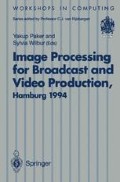Abstract
In this work, we address the issue of encoding and recognition of face sequences that arise from continuous head movement. We detect and track a moving head before segmenting face images from on-line camera inputs. We measure temporal changes in the pattern vectors of eigenface projections of successive image frames of a face sequence and introduce the concept of “temporal signature” of a face class. We exploit two different supervised learning algorithms with feedforward and partially recurrent neural networks to learn possible temporal signatures. We discuss our experimental results and draw conclusions.
Access this chapter
Tax calculation will be finalised at checkout
Purchases are for personal use only
Preview
Unable to display preview. Download preview PDF.
References
B.F. Buxton and H. Buxton. “Monocular depth perception from optic flow by space time signal processing”. Proceedings of the Royal Society of London, B-218, 1983.
A. Cleeremans. “Finite state automata and simple recurrent networks”. Neural Computation, 1, 1989.
J. Elman. “Finding structure in time”. Cognitive Science, 14, 1990.
M. Fleming and G. Cottrell. “Categorization of faces using unsupervised feature extraction”. In IJCNN, San Diego, California, 1990.
S. Gong. Parallel Computation of Visual Motion. PhD thesis, Department of Engineering Science, Oxford University, 1989.
S. Gong. “Visual observation as reactive learning”. In SPIE International Conference on Adaptive and Learning Systems, Orlando, Florida., 1992.
S. Gong and H. Buxton. “Bayesian nets for mapping contextual knowledge to computational constraints in motion segmentation and tracking”. In BMVC, Guildford, Surrey, England, 1993.
R. Kalman. “A new approach to linear filtering and prediction problems”. ASME Journal of Basic Engineering, 1960.
M. Kirby and L. Sirovich. “Application of the Karhunen-Loeve procedure for the characterization of human faces”. PAMI, 12 (1), 1990.
T. Kohonen. Self-organization and Associative Memory. Springer-Verlag, Berlin, 1989.
M. Mozer. “Neural net architecture for temporal sequence processing”. In A. Weigend and N. Gershenfeld, editors, Predicting the Future and Understanding the Past. Addison-Wesley Publishing, 1993.
A. O’Toole, H. Abdi, K. Deffenbacher, and D. Valentin. “Low-dimensional representation of faces in higher dimensions of the face space”. Optical Society of America, 10 (3), 1993.
P. Palavouzis. Head Tracking for Face Recognition. Master’s thesis, Department of Computer Science, QMW, London, 1994.
A. Psarrou and H. Buxton. “Motion analysis using recurrent neural networks”. In ICANN, Sorrento, Italy, 1994.
G. Robertson and I. Craw. “Testing face recognition systems”. In BMVC, Guildford, Surrey, England, 1993.
D. Rumelhart, G. Hinton, and R. Williams. “Learning representations by back-propagation errors”. Nature, 223, 1988.
F. Samaria. “Face segmentation for identification using hidden markov models”. In BMVC, Guildford, Surrey, England, 1993.
M. Seibert and A. Waxman. “Adaptive 3D object recognition from multiple views”. PAMI, 14 (2), 1992.
L. Sirovich and M. Kirby. “Low-dimensional procedure for the characterization of human faces”. Optical Society of America, 4 (3), 1987.
P. Torr, T. Wong, D. Murray, and A. Zisserman. “Cooperating motion processes”. In BMVC, Glasgow, Scotland, 1991.
M. Turk and A. Pentland. “Eigenfaces for recognition”. Journal of Cognitive Neuroscience, 3 (1), 1991.
Author information
Authors and Affiliations
Editor information
Editors and Affiliations
Rights and permissions
Copyright information
© 1995 British Computer Society
About this paper
Cite this paper
Gong, S., Psarrou, A., Katsoulis, I., Palavouzis, P. (1995). Tracking and Recognition of Face Sequences. In: Paker, Y., Wilbur, S. (eds) Image Processing for Broadcast and Video Production. Workshops in Computing. Springer, London. https://doi.org/10.1007/978-1-4471-3035-2_8
Download citation
DOI: https://doi.org/10.1007/978-1-4471-3035-2_8
Publisher Name: Springer, London
Print ISBN: 978-3-540-19947-2
Online ISBN: 978-1-4471-3035-2
eBook Packages: Springer Book Archive

